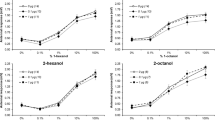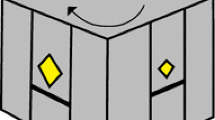Abstract
Foraging honeybees are likely to learn visual and chemical cues associated with many different food sources. Here, we explore how many such sources can be memorized and recalled. Marked bees were trained to visit two (or three) sugar feeders, each placed at a different outdoor location and carrying a different scent. We then tested the ability of the bees to recall these locations and fly to them, when the training scents were blown into the hive, and the scents and food at the feeders were removed. When trained on two feeder locations, each associated with a different scent, the bees could correctly recall the location associated with each scent. However, this ability broke down when the number of scents and feeder locations was increased to three. Performance was partially restored when each of the three training feeders was endowed with an additional cue, namely, a distinct colour. Our results suggest that bees can recall a maximum of two locations when each is associated with a different scent. However, this number can be increased if the scent cues are augmented by visual cues. These findings have implications for the ways in which associations are established and laid down in honeybee memory.



Similar content being viewed by others
References
Benard J, Giurfa M (2004) A test of transitive inferences in free-flying honeybees: unsuccessful perdormance due to memory constraints. Learn Mem 11:328–336
Collett TS (1992) Landmark learning guidance in insects. Phil Trans R Soc Lond B 337:295–303
Esch HE, Burns JE (1995) Honeybees use optic flow to measure the distance of a food source. Naturwissenschaften 82:38–40
von Frisch K (1993) The dance language and orientation of bees. Harvard University Press, London
Giurfa M, Zhang SW, Jenett A, Menzel R, Srinivasan MV (2001) The concepts of ‘sameness’ and ‘difference’ in an insect. Nature 410:930–933
Gould JL (1993) Ethological and comparative perspectives on honey bee learning. In: Papaj DR, Lewis AC (eds) Insect learning. Chapman Hall, New York, pp 18–50
Menzel R (1969) Das Gedaechtnis der Honigbiene fuer Spektralfarben II. Z vgl Physiol 63:290–309
Menzel R, Mueller U (1996) Learning and memory in honeybees: from behavior to neural substrates. Ann Rev Neurosci 19:379–404
Menzel R, Brandt R, Gumbert A, Komischke B, Kunze J (2000) Two spatial memories for honeybee navigation. Proc R Soc Lond B 267:961–968
Reinhard J, Srinivasan MV, Zhang SW (2004a) Scent-triggered navigation in honeybees. Nature 427:411
Reinhard J, Srinivasan MV, Guez D, Zhang SW (2004b) Floral scents induce recall of navigational and visual memories in honeybees. J Exp Biol 207:4371–4381
Riley JR, Smith AD, Reynolds DR, Edwards AS, Osborne JL, Williams IH, Carreck NL, Poppy GM (1996) Tracking bees with harmonic radar. Nature 379:29–30
Srinivasan MV (1994) Pattern recognition in the honeybee: recent progress. J Insect Physiol 40:183–194
Srinivasan MV, Zhang SW, Zhu H (1998) Honeybees link sights to smells. Nature 396:637–638
Srinivasan MV, Zhang SW, Altwein M, Tautz J (2000) Honeybee navigation: nature and calibration of the ‘odometer’. Science 287:851–853
Wehner R (1981) Spatial vision in arthropods. In: Autrum H (eds) Handbook of sensory physiology 7. Springer, Berlin Heidelberg New York, pp 288–616
Wehner R, Rossel S (1985) The bee’s celestial compass—a case study in behavioral neurobiology. Fortschr Zool 31:11–53
Zhang SW, Lehrer M, Srinivasan MV (1999) Honeybee memory: navigation by associative grouping and recall of visual stimuli. Neurobiol Learn Mem 72:180–201
Zhang SW, Srinivasan MV, Zhu H, Wong J (2004) Grouping of visual objects by honeybees. J Exp Biol 207:3289–3298
Acknowledgements
We thank Regan Ashby, Emily Baird, Aung Si, and Hong Zhu for their help with the experiments. This work was partly supported by the Centre for Visual Sciences, ANU, and by grants DP0208683, DP0450535 and CE0348177 from the Australian Research Council. Our experiments comply with the current Australian law, as well as the NIH “Principles of animal care”, 86–23, 1985.
Author information
Authors and Affiliations
Corresponding author
Rights and permissions
About this article
Cite this article
Reinhard, J., Srinivasan, M.V. & Zhang, S. Complex memories in honeybees: can there be more than two?. J Comp Physiol A 192, 409–416 (2006). https://doi.org/10.1007/s00359-005-0079-0
Received:
Revised:
Accepted:
Published:
Issue Date:
DOI: https://doi.org/10.1007/s00359-005-0079-0




